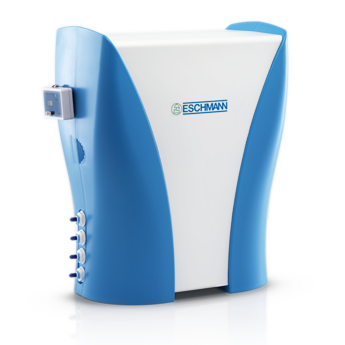The benefits of Reverse Osmosis (RO) water in your dental practice
Featured Products Promotional FeaturesPosted by: Dental Design 1st March 2023

Water is a vital component of various protocols within the dental practice. Practices use water during dental treatment, pre-sterilisation cleaning of instruments, and many sterilisation systems, such as autoclaves, also require water for operation. As such, having RO water is vital to keep your equipment in good condition, minimise unit breakdowns and reduce the risks of pathogens spreading.
Dental unit water lines and infection risk
Dental unit water lines (DUWLs) are a network of plastic tubing, valves and connectors that are prime environments for the formation of microbial biofilm. This sticky substance is an amalgamation of microorganisms such as bacteria, fungi and viruses,[i] which have adhered to interior surfaces of the DUWLs. This contamination could originate not only from the mains water, should it be piped into the dental unit, but also the draw-back of patients’ saliva – thus, more than water-borne microorganisms can present in DUWLs, including ones from the oral cavity, too.i
Biofilm formation can occur due to the type of tubing that’s used in DUWLs, namely long, small-diameter tubing that provides ample conditions for adhesion.[ii] Additionally, periods of stagnation and low water flow can also promote microbial growth.i Despite the adherence of biofilm to the interior surfaces of the DUWLs, microbes can still travel within the water flow – in fact, high microbial levels have been discovered in the water used in handpieces and air/water syringes.ii Aerosol and splatter are thus potential sources of infection during dental treatment.
The risk of Legionella pneumophila, a bacterium that can cause severe pneumonia, is also of concern. There have been numerous reports of patients succumbing to Legionnaires’ disease, and while research on the risks to dental staff is differential, one casualty has been reported as a result of this disease – Legionella was detected in the dental unit water system in their practice.[iii] According to HTM01-05 guidance, ‘at-risk systems, particularly those used with the patient, must be drained at least at the end of each working day’.[iv] Most dental chairs utilise reservoir bottled-water systems, which require regular disinfection in order to minimise the risks of infection. Purified water, such as distilled or reverse osmosis (RO) with ultra-violet (UV) treatment can be used to both fill and flush self-contained water bottles. HTM01-05 guidance states that with either of these options, the build-up of biofilm is likely to be low (as long as regular disinfection and maintenance are carried out).iii

Protecting systems from hard water
Water quality can also impact systems within the dental practice that utilise water, such as an autoclave. Hard water, which is thought to affect around 60% of the UK,[v] contains high levels of dissolved calcium and magnesium.[vi] Dental practices in hard water areas may experience calcium carbonate build-up (limescale) in their medical equipment, especially autoclaves. This can quickly lead to blocked/broken pipes and inefficient heating, compromising the sterilisation process and incurring potentially expensive repair costs. HTM01-05 guidelines advise that either distilled or RO water be used in an autoclave, as opposed to tap water, so which should you use?
During the use of distillation processes, impurities and minerals are removed from the water through boiling. The water is heated in a chamber until it evaporates into steam, which is then chilled and turned back into pure water droplets. Any contaminants are left behind in the chamber. In the RO process, water is filtered through a semi-permeable membrane that removes impurities, salt, bacteria, and organic materials. While both methods are able to produce pure water, distillers do require high levels of energy, heat and electricity, so they may not always be the most cost-effective option. In contrast, RO systems are much more economical and can produce a larger quantity of water compared to a conventional water distiller. Also, some RO systems utilise ultra-violet technology (UV) to provide further protection against pathogens.
Protect patients with pure water
The Reverse Osmosis (RO) System from Eschmann enables clinicians to have a reliable supply of RO water for use in practice. Suitable for connection to all mains cold water supplies and with WRAS complaint backflow protection, the RO system is ideal for use in autoclaves, DUWLs and for cleaning instruments. The compact size means it can fit discreetly and neatly into any available cupboard space. Plus, the RO system filters out minerals, totally dissolved solids (TDSs) and eliminates bacteria and microorganisms from the water supply, with the addition of UV technology for added protection. This way, it guarantees water that is safe for use throughout your whole practice.
Purified water is an essential resource in dental practices, and a vital component of your infection control protocols. With safe, clean water, you’re guaranteed the peace of mind that your sterilisation systems remain in good condition and the risks of waterborne infections are reduced.
For more information on the highly effective and affordable range of infection control products from Eschmann, please visit www.eschmann.co.uk or call 01903 875787
[i] Spagnolo, A.M., Sartini, M. and Cristina, M.L. (2020). Microbial Contamination of Dental Unit Waterlines and Potential Risk of Infection: A Narrative Review. Pathogens, [online] 9(8). Available at: https://www.ncbi.nlm.nih.gov/pmc/articles/PMC7460066/ [Accessed 7 Nov. 2022].
[ii] Tuvo, B., Totaro, M., Cristina, M.L., Spagnolo, A.M., Di Cave, D., Profeti, S., Baggiani, A., Privitera, G. and Casini, B. (2020). Prevention and Control of Legionella and Pseudomonas spp. Colonization in Dental Units. Pathogens, [online] 9(4), p.305. Available at: https://www.ncbi.nlm.nih.gov/pmc/articles/PMC7238104/ [Accessed 8 Nov. 2022].
[iii] Petti, S. and Vitali, M. (2017). Occupational risk forLegionellainfection among dental healthcare workers: meta-analysis in occupational epidemiology. BMJ Open, [online] 7(7), p.e015374. Available at: https://www.ncbi.nlm.nih.gov/pmc/articles/PMC5734417/#R4 [Accessed 9 Nov. 2022].
[iv] www.england.nhs.uk. (n.d.). NHS England» (HTM 01-05) Decontamination in primary care dental practices. [online] Available at: https://www.england.nhs.uk/publication/decontamination-in-primary-care-dental-practices-htm-01-05/ [Accessed 8 Nov. 2022].
[v] www.scaleguard.co.uk. (n.d.). Water Hardness Areas in the UK. [online] Available at: https://www.scaleguard.co.uk/hard-water-areas.html#:~:text=Around%2060%25%20of%20the%20UK [Accessed 8 Nov. 2022].
[vi] Sengupta, P. (2013). Potential health impacts of hard water. International journal of preventive medicine, [online] 4(8), pp.866–75. Available at: https://www.ncbi.nlm.nih.gov/pmc/articles/PMC3775162/ [Accessed 8 Nov. 2022].








